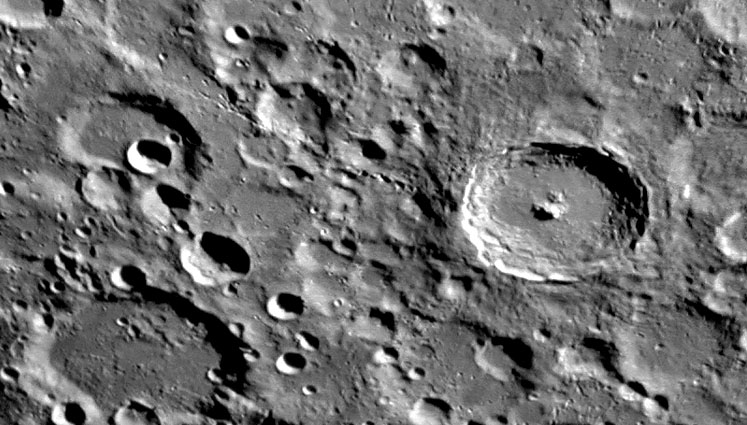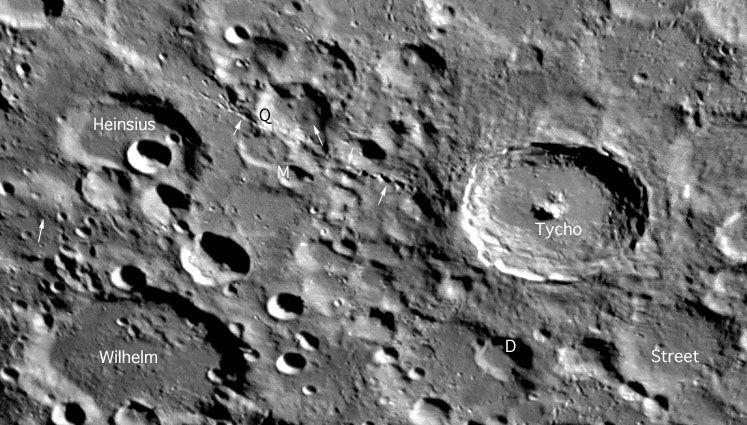Difference between revisions of "October 21, 2004"
| (16 intermediate revisions by the same user not shown) | |||
| Line 1: | Line 1: | ||
__NOTOC__ | __NOTOC__ | ||
| − | =60 | + | =60 Inches of Tycho= |
| + | <!-- Start of content --> | ||
<table width="85%" border="0" align="center" cellpadding="6" cellspacing="2"> | <table width="85%" border="0" align="center" cellpadding="6" cellspacing="2"> | ||
<tr> | <tr> | ||
| − | |||
</tr> | </tr> | ||
</table> | </table> | ||
<table width="85%" border="0" align="center" cellpadding="6" cellspacing="2"> | <table width="85%" border="0" align="center" cellpadding="6" cellspacing="2"> | ||
<tr><td colspan="2" valign="top"><div align="center"> | <tr><td colspan="2" valign="top"><div align="center"> | ||
| − | + | <!-- Mouse style 1 --> | |
| − | + | {{HoverImage|LPOD-2004-10-21.jpeg|LPOD-2004-10-21b.jpeg}} | |
| − | |||
| − | |||
</div></td> | </div></td> | ||
</tr> | </tr> | ||
</table> | </table> | ||
<table width="80%" border="0" align="center" cellpadding="8"> | <table width="80%" border="0" align="center" cellpadding="8"> | ||
| − | <tr><td><div align="center" class="main_sm">Image Credit: [mailto:ccook@cape.com Chris Cook]</p> | + | <tr><td><div align="center" class="main_sm"><p>Image Credit: [mailto:ccook@cape.com Chris Cook]</p> |
</div></td> | </div></td> | ||
</tr> | </tr> | ||
| Line 22: | Line 20: | ||
<br> | <br> | ||
<table class="story" border="0" bgcolor="#FFFFFF" width="90%" cellpadding="10" align="center"><tr><td> | <table class="story" border="0" bgcolor="#FFFFFF" width="90%" cellpadding="10" align="center"><tr><td> | ||
| − | <p align="center"><b>60 | + | <p align="center"><b>60 Seconds of Tycho </b></p> |
<p align="left">Do you have aperture fever? Do you crave a big scope - a 14" or maybe an 18"? If so, I say, stop thinking small! You can use the Mt Wilson 60" reflector for your lunar studies. This image was taken afocally at the big scope's Cassegrain focus with a standard digital camera. As Chris Cook says anyone can reserve a night on the 60" through the [http://www.mtwilson.edu/ Mt Wilson Institute.] The fee is $900 for a full night. So get together 9 of your closest astro-buddies and take the images of a lifetime for half the cost of a specialty eyepiece. If you have mastered your imaging techniques and have good seeing you might capture images like this. The floor of Tycho is smooth with impact melt - the same material that makes a dark ring around Tycho at full Moon, but what shows up remarkably well is the chain of small secondary craters (arrowed on mouseover) to the northwest. These well-resolved craters are about 1.5 km wide. Also note that most of this field is peppered with a roughness that is partially due to Tycho ejecta raining down everywhere. But look at the floor of Tycho D and other nearby small craters. The smoothness of these floors suggests younger surfaces that are hard to explain. Also note the small domical hill on the floor of Heinsius Q - is that a lump of secondary ejecta, a wall slump, or a highland dome? Another peculiar rounded mound is arrowed SW of Heinsius. High resolution views always bring new questions!</p> | <p align="left">Do you have aperture fever? Do you crave a big scope - a 14" or maybe an 18"? If so, I say, stop thinking small! You can use the Mt Wilson 60" reflector for your lunar studies. This image was taken afocally at the big scope's Cassegrain focus with a standard digital camera. As Chris Cook says anyone can reserve a night on the 60" through the [http://www.mtwilson.edu/ Mt Wilson Institute.] The fee is $900 for a full night. So get together 9 of your closest astro-buddies and take the images of a lifetime for half the cost of a specialty eyepiece. If you have mastered your imaging techniques and have good seeing you might capture images like this. The floor of Tycho is smooth with impact melt - the same material that makes a dark ring around Tycho at full Moon, but what shows up remarkably well is the chain of small secondary craters (arrowed on mouseover) to the northwest. These well-resolved craters are about 1.5 km wide. Also note that most of this field is peppered with a roughness that is partially due to Tycho ejecta raining down everywhere. But look at the floor of Tycho D and other nearby small craters. The smoothness of these floors suggests younger surfaces that are hard to explain. Also note the small domical hill on the floor of Heinsius Q - is that a lump of secondary ejecta, a wall slump, or a highland dome? Another peculiar rounded mound is arrowed SW of Heinsius. High resolution views always bring new questions!</p> | ||
| − | <blockquote><p align="right">— [mailto:tychocrater@yahoo.com Chuck Wood]</blockquote> | + | <blockquote> |
| − | <p align="left" | + | <p align="right">— [mailto:tychocrater@yahoo.com Chuck Wood]</p></blockquote> |
| + | <p align="left"><b>Technical Details:</b><br> | ||
June 30, 2001, 8:18 pm PDT. Mt Wilson 60" reflector at the f/16 Cassegrain focus (24,384mm focal lenght) with a 100mm Masuyama Kellner eyepiece + Nikon Coolpix 800 digital camera, exposure: 1/30th second; minor enhancement in Adobe Photoshop 6.0.</p> | June 30, 2001, 8:18 pm PDT. Mt Wilson 60" reflector at the f/16 Cassegrain focus (24,384mm focal lenght) with a 100mm Masuyama Kellner eyepiece + Nikon Coolpix 800 digital camera, exposure: 1/30th second; minor enhancement in Adobe Photoshop 6.0.</p> | ||
<p><b>Related Links:</b><br> | <p><b>Related Links:</b><br> | ||
| − | [www.cookphoto.com Chris Cook Photography] | + | ["www.cookphoto.com" Chris Cook Photography] |
<br>Rukl <i>Atlas of the Moon,</i> Sheet 64 | <br>Rukl <i>Atlas of the Moon,</i> Sheet 64 | ||
| − | <p | + | </p> |
| + | <p><b>Yesterday's LPOD:</b> [[October 20, 2004|Rough Domes]] </p> | ||
| + | <p><b>Tomorrow's LPOD:</b> [[October 22, 2004|H-Alpha Moon]] </p> | ||
</tr> | </tr> | ||
</table> | </table> | ||
| Line 41: | Line 42: | ||
<p align="center" class="main_titles"><b>Author & Editor:</b><br> | <p align="center" class="main_titles"><b>Author & Editor:</b><br> | ||
[mailto:tychocrater@yahoo.com Charles A. Wood]</p> | [mailto:tychocrater@yahoo.com Charles A. Wood]</p> | ||
| − | < | + | <!-- Cleanup of credits --> |
| − | + | <!-- Cleanup of credits --> | |
| − | < | + | <!-- Cleanup of credits --> |
| − | + | <!-- Cleanup of credits --> | |
| − | + | <!-- Cleanup of credits --> | |
| − | < | + | <!-- Cleanup of credits --> |
| − | < | + | <!-- Cleanup of credits --> |
| − | + | <!-- Cleanup of credits --> | |
| − | < | + | <!-- Cleanup of credits --> |
| − | + | <!-- Cleanup of credits --> | |
</td></tr> | </td></tr> | ||
</table> | </table> | ||
<p> </p> | <p> </p> | ||
| − | ---- | + | <!-- End of content --> |
| − | + | {{wiki/ArticleFooter}} | |
| − | |||
Latest revision as of 15:19, 15 March 2015
60 Inches of Tycho
Image Credit: Chris Cook |
|
60 Seconds of Tycho Do you have aperture fever? Do you crave a big scope - a 14" or maybe an 18"? If so, I say, stop thinking small! You can use the Mt Wilson 60" reflector for your lunar studies. This image was taken afocally at the big scope's Cassegrain focus with a standard digital camera. As Chris Cook says anyone can reserve a night on the 60" through the Mt Wilson Institute. The fee is $900 for a full night. So get together 9 of your closest astro-buddies and take the images of a lifetime for half the cost of a specialty eyepiece. If you have mastered your imaging techniques and have good seeing you might capture images like this. The floor of Tycho is smooth with impact melt - the same material that makes a dark ring around Tycho at full Moon, but what shows up remarkably well is the chain of small secondary craters (arrowed on mouseover) to the northwest. These well-resolved craters are about 1.5 km wide. Also note that most of this field is peppered with a roughness that is partially due to Tycho ejecta raining down everywhere. But look at the floor of Tycho D and other nearby small craters. The smoothness of these floors suggests younger surfaces that are hard to explain. Also note the small domical hill on the floor of Heinsius Q - is that a lump of secondary ejecta, a wall slump, or a highland dome? Another peculiar rounded mound is arrowed SW of Heinsius. High resolution views always bring new questions! Technical Details: Related Links: Yesterday's LPOD: Rough Domes Tomorrow's LPOD: H-Alpha Moon |
|
Author & Editor: |
COMMENTS?
Register, Log in, and join in the comments.





